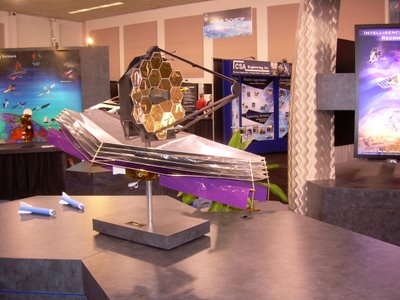Into the Infrared

The James Webb Space Telescope will extend our observations into the far-infrared, putting us a bit closer to the Big Bang. I had the good fortune to interview with Chief Scientist John Mather, who just won the Nobel Prize for his work on COBE. Since JWST will look at similiar wavelengths to SNAP/JDEM, it can also be used to find high-redshift supernovae. Such a survey could be done at extremely low cost because it could be "piggybacked" onto other observations. Robert Kirschner has a proposal to do exactly that. JWST wil be able to find 50-100 supernovae, less than the thousands a dedicated mission could find but enough to verify that c has been changing.
The Spitzer Space Telescope has shown us some fascinating pictures from the infrared sky. This is Herbig-Haro object 49-50, a baby star in the making. It spirals through a dust cloud jetting off radiation in its wake. A tiny Black Hole would behave exactly like this. Jets are a telltale sign of a singularity.

Another two galaxies are mating, NGC 2207 and IC 2163. Their cores burn blue with high-energy radiation, while their disks glow in the infrared. The many blue spots reveal additional singularites in addition to those at the galactic cores. Galaxies could be full of Black Holes.

Though it is touted as a sucessor to the Hubble Space Telescope, JWST will look at different wavelengths. Hubble will long be valuable for its optical and ultraviolet capabilities. Hopefully HST can be refurbished for a long life.



6 Comments:
Hi Louise
Those conference posters in the background are just gorgeous! It's like fairyland wherever you are. I can't wait for your book to come out. With any luck, my collaborator and I will have some good evidence for a QG construction of the SM soon. Cheers.
With the mating galaxies are we sure that they are colliding or could the smaller one be an 'offshoot' (baby)? Such beauty in the universe. It will be very interesting to see the 'other end' of the spectrum.
Hi Louise,
Could you let me have the original link to the "mating galaxies"
Thanks!
HI all. Kea is generous as always.
Rae Ann, that is a good question but currently it is interpreted as 2 galaxies mating. it would be very difficult for the central Black Hole to produce an offshoot.
Q9, the pretty pink picture (like a carnival mask!) is available here. You are always nice in assigning credit.
Hi Louise,
Thanks for the link
you are magical as usual. - Q.
The Spitzer Space Telescope has shown us some fascinating pictures from the infrared sky. This is Herbig-Haro object 49-50, a baby star in the making. It spirals through a dust cloud jetting off radiation in its wake. A tiny Black Hole would behave exactly like this. Jets are a telltale sign of a singularity.germany jewerly , usa jewerly
Post a Comment
<< Home